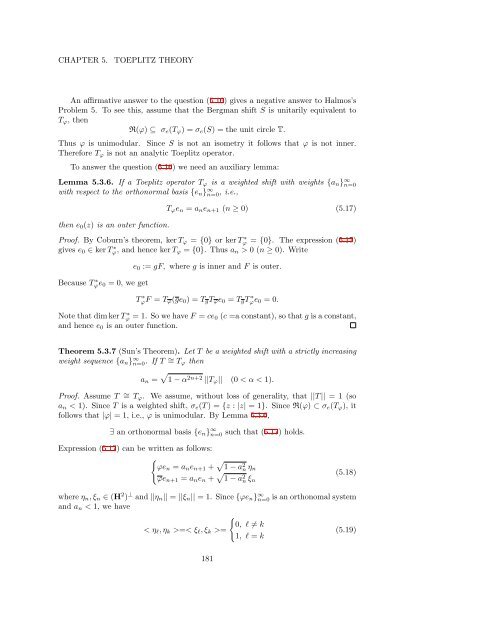Woo Young Lee Lecture Notes on Operator Theory
Woo Young Lee Lecture Notes on Operator Theory
Woo Young Lee Lecture Notes on Operator Theory
Create successful ePaper yourself
Turn your PDF publications into a flip-book with our unique Google optimized e-Paper software.
CHAPTER 5.<br />
TOEPLITZ THEORY<br />
An affirmative answer to the questi<strong>on</strong> (5.16) gives a negative answer to Halmos’s<br />
Problem 5. To see this, assume that the Bergman shift S is unitarily equivalent to<br />
T φ , then<br />
R(φ) ⊆ σ e (T φ ) = σ e (S) = the unit circle T.<br />
Thus φ is unimodular. Since S is not an isometry it follows that φ is not inner.<br />
Therefore T φ is not an analytic Toeplitz operator.<br />
To answer the questi<strong>on</strong> (5.16) we need an auxiliary lemma:<br />
Lemma 5.3.6. If a Toeplitz operator T φ is a weighted shift with weights {a n } ∞ n=0<br />
with respect to the orth<strong>on</strong>ormal basis {e n } ∞ n=0, i.e.,<br />
then e 0 (z) is an outer functi<strong>on</strong>.<br />
T φ e n = a n e n+1 (n ≥ 0) (5.17)<br />
Proof. By Coburn’s theorem, ker T φ = {0} or ker T ∗ φ = {0}. The expressi<strong>on</strong> (5.17)<br />
gives e 0 ∈ ker T ∗ φ, and hence ker T φ = {0}. Thus a n > 0 (n ≥ 0). Write<br />
Because T ∗ φe 0 = 0, we get<br />
e 0 := gF, where g is inner and F is outer.<br />
T ∗ φF = T φ (ge 0 ) = T g T φ e 0 = T g T ∗ φe 0 = 0.<br />
Note that dim ker T ∗ φ = 1. So we have F = ce 0 (c =a c<strong>on</strong>stant), so that g is a c<strong>on</strong>stant,<br />
and hence e 0 is an outer functi<strong>on</strong>.<br />
Theorem 5.3.7 (Sun’s Theorem). Let T be a weighted shift with a strictly increasing<br />
weight sequence {a n } ∞ n=0. If T ∼ = T φ then<br />
a n = √ 1 − α 2n+2 ||T φ || (0 < α < 1).<br />
Proof. Assume T ∼ = T φ . We assume, without loss of generality, that ||T || = 1 (so<br />
a n < 1). Since T is a weighted shift, σ e (T ) = {z : |z| = 1}. Since R(φ) ⊂ σ e (T φ ), it<br />
follows that |φ| = 1, i.e., φ is unimodular. By Lemma 5.3.6,<br />
∃ an orth<strong>on</strong>ormal basis {e n } ∞ n=0 such that (5.17) holds.<br />
Expressi<strong>on</strong> (5.17) can be written as follows:<br />
{<br />
φe n = a n e n+1 + √ 1 − a 2 n η n<br />
φe n+1 = a n e n + √ 1 − a 2 n ξ n<br />
(5.18)<br />
where η n , ξ n ∈ (H 2 ) ⊥ and ||η n || = ||ξ n || = 1. Since {φe n } ∞ n=0 is an orth<strong>on</strong>omal system<br />
and a n < 1, we have<br />
{<br />
0, l ≠ k<br />
< η l , η k >=< ξ l , ξ k >=<br />
(5.19)<br />
1, l = k<br />
181













